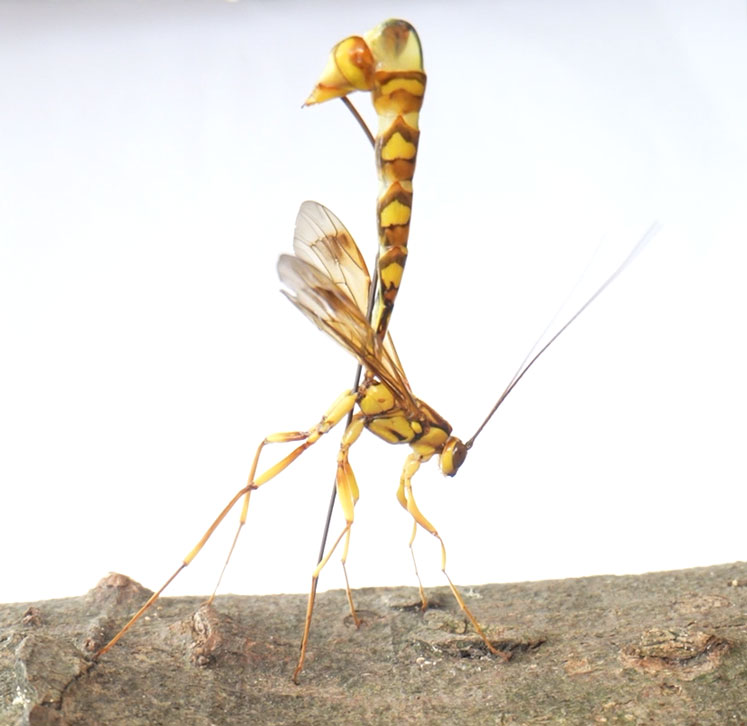Buckling Without Breaking
By Meagan Mulcair
Inspiration from a wasp could improve long, thin engineered structures.
August 12, 2024
From The Staff Biology Engineering Medicine Physics Technology Anatomy Animal Behavior Morphology Physiology Zoology
At the height of summer in mainland China, a group of robotics engineers chose to go out into the field and surround themselves with gigantic, parasitic wasps. “I remember the temperature was very high. It reached 40 degrees Celsius,” Rongwei Wen recalls. “It was very hard to capture videos and images. We were out there for several weeks.” Many people would cower from the Megarhyssa wasp, whose body can measure twice the length of a hornet and a whopping four times that of a yellow jacket, but it poses no threat to humans. What might be mistaken for a terrifyingly long stinger—almost the same length as the wasp’s body—is actually the insect’s ovipositor, which it uses to bore holes into wood and lay eggs. Wen and his colleagues in the Bionics and Control Lab at Hong Kong University braved the searing heat to study this sturdy, flexible structure, which they think could help guide the design and development of robotic structures.

Reprinted with permission of AAAS from R. Wen, et al., 2023, Science Advances 9:eadi8284. CC BY-NC 4.0
The Megarhyssa wasp ovipositor is an example of a structure that in engineering is called a slender element—one that is much longer than it is wide, such as a beam, column, or a hypodermic needle. Rather than snapping, these structures are prone to buckling when subjected to too heavy a load, which can increase safety. Slender elements are essential to access difficult-to-reach spaces and have applications in a range of fields, from medicine to oil and gas exploration. As technology becomes increasingly intricate and streamlined, researchers aim to develop the smallest parts possible to save space. As Wen puts it, “The thinner the strip, the better.” Now, in a study published in Science Advances, Wen and his team debuted the slender elements they developed based on the wasp ovipositor mechanism: A microneedle capable of piercing human skin, and a robotics component for safe power transmission.
Wen and his team began by studying the structure and function of the wasp ovipositor. They found that the Megarhyssa ovipositor is split into two small valves, which work together to anchor the structure to the wood and deposit eggs. The team also modeled the structural properties of the ovipositor and found that, to avoid damage, it buckles immediately when met with excessive force. When the force is removed, the ovipositor automatically regains its stiffness. The engineers fabricated a 2D microneedle based on this structure, using fishing wire to bind together two steel styluses with beveled tips and fin-like barbs on their side walls. They then tested whether the microneedle was strong enough to penetrate human skin using silicone as a proxy, and found that, relative to other microneedles, it was able to withstand more than twice the penetrative force.
Reprinted with permission of AAAS from R. Wen, et al., 2023, Science Advances 9:eadi8284. CC BY-NC 4.0
Wen hopes that these slender elements could one day be used to treat gliosis, a disorder that leads to scarring on the brain in patients with neurological illnesses such as multiple sclerosis and Alzheimer’s disease. To treat gliosis, brain tissue can be probed to stimulate and record neuron signals. However, designing a suitable probe for penetration is difficult, Wen explains: “The [slender component] is deep in the brain tissue and can damage it if it is too hard, but if it is softer than the brain tissue, it cannot be inserted.” The wasp-inspired mechanism offers a potential Goldilocks solution, capable of penetrating tissue while protecting the patient.
Reprinted with permission of AAAS from R. Wen, et al., 2023, Science Advances 9:eadi8284. CC BY-NC 4.0
The tendency to reversibly buckle could also afford slender elements a key role in developing intrinsic safety in robotics. To ensure that a robot stops working under dangerous conditions, the circuit of power transmission between internal parts can be designed to fail with excessive stress. To test the use of slender components as a robotic failsafe, the engineers designed a robot arm of their own. The group’s robotic arm consisted of a wrist joint attached to a slender component made of two touching plastic strips held in place by tension, mimicking the behavior of the wasp ovipositor when in motion. In a simulated collision, the plastic strips buckled immediately, much like the wasp ovipositor. In this way, the robot automatically entered a safety mode as the slender component lost its stiffness. Like the ovipositor, the strips sprung back into place after the collision and the robot functioned normally again without the need for any human intervention.
The device is built from standard materials and components, but the way it is assembled under tension gives the final structure strength and flexibility. Although seemingly simple, this slender element design is, as Wen remarks, “more than the sum of its parts.”
American Scientist Comments and Discussion
To discuss our articles or comment on them, please share them and tag American Scientist on social media platforms. Here are links to our profiles on Twitter, Facebook, and LinkedIn.
If we re-share your post, we will moderate comments/discussion following our comments policy.